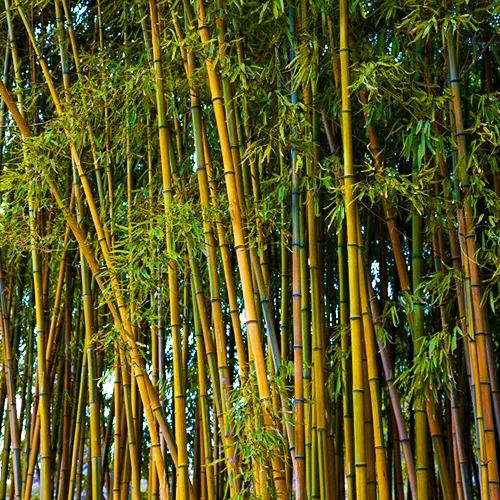The Story of Bamboo
A History Rooted in Tradition
Human civilization has maintained a long-standing relationship with the Bamboo Plant for hundreds of years. Ancient records from both China and India reveal that the it has been around for thousands of years. Ancient documents describe it as an essential component in the creation of paper as well as building materials and weapons. Various cultures held it in high esteem because of its strength, which was paired with flexibility and quick regrowth, which symbolized both resilience and prosperity. The plant possessed spiritual meaning in Japan because people planted it near temples to protect against evil forces. People from indigenous tribes worldwide utilized its robust stalks in their everyday lives to create tools, baskets, and musical instruments.
Archaeological data shows that its discovery happened before written records and it was first used by ancient societies that understood its abilities to provide both shelter and food. The Han Dynasty scripts (206 BCE – 220 CE) describe how writing on scrolls became common, which led to the creation of paper. Throughout history, Asian and South American societies have integrated this resource into their architecture and cuisine while making it a fundamental part of their cultural rituals. The expansion of exploration and trade enabled its reach to every continent where it became commonplace in tropical and subtropical zones.
Bamboo Plant A Natural Healer Through the Ages
The Bamboo Plant has long held medicinal value beyond its aesthetic and structural attributes. Herbal remedies from Traditional Chinese medicine incorporated this natural element to treat fevers as well as respiratory and digestive problems. Traditional medical practices utilized its shoot extracts for their ability to cool the body while alleviating inflammation and detoxifying the system. Ayurvedic medicine utilizes the resin from its stalks for wound healing and infection treatment.
Indigenous healers from South America and Africa used it to produce salves and teas which supported digestive health and enhanced general wellness. Scientific studies today have verified that its high silica content makes it helpful for strengthening bones as well as hair and skin. Today, herbalists combine this ingredient in supplements that promote joint health and collagen production. Its natural antibacterial and antifungal properties this plant remains a key component in holistic wellness treatments that have been used successfully for generations.
A Stunning Addition to Landscapes
Its stunning appearance and adaptability make this species a popular option for landscapes. This versatile plant serves multiple functions including privacy screens and windbreaks while adding ornamental elegance to outdoor areas. This species thrives across different climates and soil types which makes it a perfect option for gardeners who want a hardy plant that requires minimal upkeep.
Traditional Japanese gardens showcase bamboo plants in expertly designed arrangements that enhance peaceful water features along with stone paths. Contemporary landscaping makes use of lush green walls created with this material as a sustainable fencing option. Its stalks display rich colors that span from deep emerald to golden tones enabling it to integrate effortlessly into various design aesthetics including tropical and minimalist Zen garden styles. The non-deciduous leaves maintain the plant's visual charm throughout the year while providing a changing feature that adapts to different seasons.
Bamboo Plant A Living Work of Art
This species stands out because most plants do not reach its level of architectural elegance and stunning beauty. The plant's tall and slender stalks rise effortlessly toward the sky creating a visual experience akin to a sculpture. Some species display vivid color shifts from green to deep blue or black as they mature. The way it grows in segments creates attractive patterns that contribute to its visual appeal and improve any surroundings.

Its foliage holds equal appeal through its gentle leaves which dance elegantly with every breeze. The plant produces tiny flowers that appear only during specific seasons, creating an air of mystery throughout its lifecycle. The majority of species retain their evergreen nature but some change color gradually as their leaves develop golden or reddish hues during cold seasons. This species maintains its position as a stunning natural creation because it can thrive in multiple climates and varying elevations.
A Haven for Rare Wildlife
While this species offers practical and aesthetic benefits it plays a vital role as a living space for numerous distinctive wildlife populations. The giant panda represents one of the most famous beneficiaries since it depends on this species as its main food source. The dense forests where this species flourishes provide essential nourishment and shelter to red pandas, lemurs, and various bird species. Small mammals along with amphibians and reptiles find protection in dense thickets which offer them shelter from predators and extreme weather conditions.
Numerous endangered insects, such as butterfly and beetle species, receive essential sustenance from their ecosystem. Certain bird species depend solely on their groves for nesting because they provide both protection and plentiful food resources. The preservation of biodiversity in wetland areas depends greatly on this entity because it stabilizes soil and prevents erosion while providing an optimal habitat for aquatic organisms. Environmental experts emphasize this resource's critical role in protecting fragile ecosystems and promoting responsible harvesting techniques to maintain benefits for both wildlife and people.
Bamboo Plant The Legacy Continues
No other species has had such a significant and enduring influence on human civilization as this one. The Bamboo Plant serves as a bridge between its ancient medicinal and cultural heritage and its current role in sustainable living practices while continuing to impact our world across many domains. This species stands as a demonstration of nature’s inventive power because people celebrate its aesthetic quality and harvest its durability while others prize its ecological importance. The growing demand for sustainable materials and regenerative landscape design proves that its timeless elegance and versatility will make it a lasting fixture in gardens, architecture, and medicine across future generations.